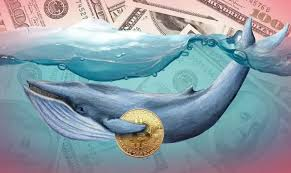A detailed and organized explanation about crypto whales in Arabic, in a practical manner that you can apply if you are following the market or trading.
What are 'whales'?
Whales are holders of a large amount of a specific cryptocurrency (like Bitcoin, Ethereum, or stablecoins). This term expresses the relative power of the size they hold — the larger the amount relative to the total supply or market liquidity, the greater their impact.
Who are whales typically?
Institutions and investment firms (funds, companies holding crypto treasuries).
Centralized exchanges (exchange wallets hold a lot of liquidity).
Founders and Miners Late (early investors like IPO investors or large Bitcoin miners).
High net worth individual investors or OTC agency networks (over-the-counter trades).

How do whales affect the market?
Rapid price movement: A large trade may cause liquidity withdrawal and rapid rise/fall.
Liquidity contraction / slippage: Executing a large trade changes the execution price compared to the expected market price.
Creating panic or FOMO: A large move to exchanges may be interpreted as a beginning of a sell-off, and vice versa.
Potential manipulation: Some whales use spoofing orders or OTC coordination to raise/lower the price.
Changes in margin and liquidation risks: Their large movements can lead to cascading liquidations.
How to detect whale activity (practical indicators)
Large on-chain transfers between wallets and/or to exchanges (indicator of potential selling supply entry).
Change in exchange reserves: Increasing balance on exchanges ≈ potential selling pressure.
Large trades in the order book (buy/sell walls) or suddenly removing them.
Unusual trade volume and large transactions in the mempool.
Track known addresses (wallets of large investors) if their addresses are publicly known.
Commonly used tools and sources (direct and tried)
Blockchain explorers to monitor transfers (for example, to monitor large TXs).
Whale Alert Services (alerts on Twitter/Telegram or bots reporting large transactions).
On-chain analytics platforms display wallet balances, exchange flows, and holding indicators.
Order book trackers and liquidity data in exchanges.
(If you'd like, I can provide practical examples of specific tools and how to set alerts — just let me know if you prefer it by default or for a specific currency.)

Trading and psychological strategies when whale activity appears.
Do not automatically follow the movement: whales may be correcting the market or executing OTC trades that do not affect you.
Use limit orders to reduce slippage.
Monitor exchange flows more than noise — a large inflow to an exchange usually indicates stronger signals than a tweet.
Separate your position by size and risk management (position sizing, logical stop-loss).
Know the time frame: Whale movements over the long term differ from momentary noise.
Risks and Ethics
Manipulation: Some activities may be legally gray or illegal depending on the country (like coordination or insider information use).
Tracking whales is not a guaranteed strategy: what works with one whale may fail with another.
Incomplete information: You can't always know the intent of the party moving the funds (selling, holding, transferring between personal wallets).
Quick Checklist for Tracking Whales
1. Monitor large on-chain transfers of the currency you are interested in.
2. Monitor exchange balance changes (inflow/outflow).
3. Check the order book before executing large trades.
4. Do not enter with leveraged doubling when there is sudden whale movement.
5. Set an exit plan (TP/SL) before you enter.
#BTCOvertakesAmazon #Notcoin #BinanceAlphaAlert #ETH4500Next?

